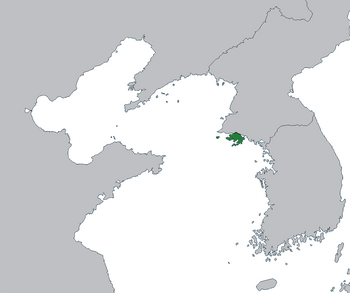Annam
Annam 안암 | |
|---|---|
| Anthem: God Save the Queen | |
 Location of Annam (dark green) | |
| Status | British Overseas Territory |
| Capital | Masan |
| Official languages | English, Korean |
| Ethnic groups (2018) | 94% Korean 3% Chinese 2% Japanese 1% Other |
| Demonym(s) | Annamese |
| Government | Constitutional monarchy, parliamentary democracy |
• Monarch | Elizabeth II |
• Governor | Penelope Tudor |
• Chief Secretary | Noh Jung-min |
| Legislature | Parliament |
| Senate | |
| House of Commons | |
| Establishment | |
• British occupation | 1845 |
• Imperial Japanese military occupation | 1940 to 1945 |
• North Korean occupation | 1950 to 1950 |
| Area | |
• | 1,522 km2 (588 sq mi) |
| Population | |
• 2018 estimate | 6,254,200 (109th) |
• Density | 4,109/km2 (10,642.3/sq mi) |
| GDP (PPP) | 2018 estimate |
• Total | $410,444,000,000 (45th) |
• Per capita | $65,627 (9th) |
| Currency | Annamese Pound (AMP) |
| Time zone | UTC+9 |
| Date format |
|
| Driving side | left |
| Calling code | +641 |
| Internet TLD | .am |
Annam (Hangul: 안암) is a city-state and British Overseas Territory in the Korean Peninsula. It is located on the Ongjin Peninsula, and shares a land border with North Korea. As a British Overseas Territory, Annam has internal self-government, and the United Kingdom is responsible for its foreign affairs and defence.
In 1845, British East India Company officer Sir Robert Boucher established a trading port in the area of present Masan after purchasing the land from the Joseon court. By 1860, the territory, now a Crown colony named Annam and a flourishing trading port, had expanded to cover the entire Ongjin Peninsula. Annam remained under British control during Japanese occupation of Korea, until 1940. Annam returned to British control following the Second World War, but was briefly occupied by the North Korean military for several months in 1950 during the Korean War, before returning once again to British sovereignty. Due to the ongoing Korean conflict and Annam's precarious location in the midst of that conflict, Annam has anomalously remained a British Overseas Territory since 1950, although political reforms in the 1990s have granted the territory substantial democratic self-government.
Annam has been a leading regional commercial port since the 19th Century, and remains today one of the world's leading financial centres and global cities with one of the highest per capita incomes in the world. It is one of the so-called Asian Tiger economies, having experienced rapid growth and industrialisation in the second half of the 20th Century. It is known as one of the most laissez-faire economies in the world, and consistently ranks near the top of indices of economic freedom, as well as measures of quality of life including the Human Development Index. The majority of Annam's population and workforce are ethnic Koreans, many of whom migrated from South Korea in the 20th Century, but there are also a substantial number of non-Korean workers and residents in Annam, particularly Japanese and Chinese, as well as a significant minority of British and Commonwealth expats.
Although essentially a British colony whose defence and foreign affairs remain the responsibility of the United Kingdom, Annam has enjoyed internal democratic self-government since the political reforms of the 1990s that culminated in the passage of the Annam Act by the British Parliament in 1996. While the Governors of Annam continue to be appointed by the British government, Westminster parliamentary government now prevails in Annam. The current Governor of Annam is Penelope Tudor and the Chief Secretary of Annam since 2014 has been Noh Jung-min.
Etymology
History
Geography
Government
Annam is a British Overseas Territory with full democratic self-government. Annam's constitution is embodied in a number of constitutional instruments, most notably the Letters Patent of 1909 and the Annam Act of 1996. While the British monarch is sovereign over Annam and the British Parliament has supreme legislative authority over the territory, Annam's domestic political and legislative affairs are under the competence of the Annamese Parliament and the local territorial administration of the Chief Secretary. Annam has a Westminster style parliamentary government modelled after the British political system.
Executive power rests in the Governor of Annam, who continues to be a British national appointed by the British government. Prior to the introduction of representative government in the 1990s, the Governor administered the territory autocratically. Presently, apart from the limited matters on which the Governor acts on the instructions of the British government, the Governor of Annam acts only on the advice of ministers of the elected local administration. The local administration is led by the Chief Secretary, who, pursuant to Westminster conventions, is the leader of the party or coalition which holds the confidence of the elected House of Commons. The Chief Secretary and other Ministers of the Crown sit in the Executive Council.
The Parliament of Annam is the bicameral legislature of Annam and comprises the elected House of Commons and the appointed Senate. It was established in 1996 under the Annam Act, replacing the fully-appointed unicameral Legislative Council. The House of Commons consists of 120 Members of Parliament elected in single-member constituencies under the First Past the Post electoral system. The Senate consists of 50 Senators appointed for life by the Governor on the advice of the Chief Secretary, with the confirmation of the Senate itself. The Commons, the "lower house", is the more powerful of the two chambers, as it controls taxation and supply and it is the house from which the government is drawn. The Senate, the "upper house", is the weaker chamber of "sober second thought" designed to draw upon its members' experience and judgment. The Parliament of Annam, and its powers, functions, officers and procedures, was modelled closely on the British Parliament, particularly in the distinction between a powerful elected lower house and a weaker aristocratic upper house, although the Senate is also, in character and composition, the successor to the former Legislative Council.
The legal system of Annam is based on English common law, and Annam's courts and legal profession are modelled on the English system. The Supreme Court is the highest territorial court in Annam, although appeals may be brought from the Supreme Court to the Judicial Committee of the Privy Council in London. Supreme Court judges are appointed by the Governor on the advice of the Chief Secretary, typically upon consultation with the judiciary and the legal profession. Proceedings in Annamese courts may be conducted either in English or Korean depending on the needs of the case, although proceedings in the higher courts are invariably conducted in English.
Politically Annam has a two-party system, consisting of the Conservative Party and the Liberal Party. The Conservative Party is broadly right wing and classically liberal, while the Liberal Party is broadly centrist and progressive. The Conservative Party has been in government since 2015 under current Chief Secretary Noh Jung-min. Since the first democratic parliamentary elections in Annam in 1996, the territory has been under Conservative government for 15 years and under Liberal government for 8 years.





